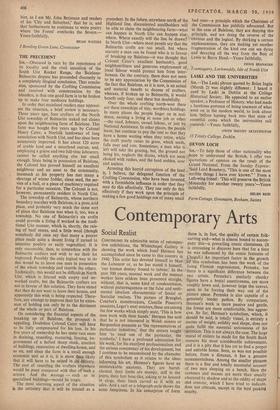Contemporary Arts
Social Realist
CONTINUING its admirable series of retrospec- tive exhibitions, the Whitechapel Gallery is showing the work which Josef Herman has accomplished since he came to this country in 1940. This artist has devoted himself to Man the Labourer or, as he has stated it himself, 'our human destiny bound to labour.' In the past 500 years, manual work and the manual worker have seldom been presented straight, without, that is, some kind of condescension, without picturesqueness or the false and senti- mental idealism characteristic of Social or Socialist realism. The picture of Brueghel, Courbet's stonebreakers, Camille Pissarro's peasants, Leger's steel erectors, these are among the few works which simply state, 'This is how men work with their hands.' Herman has said that he is not interested in Welsh miners or Burgundian peasants as 'the representatives of particular industries,' that the miners taught him 'to read out of the particular, the symbolic.' I have a profound admiration for his work, for his excellent professionalism and the serious consistency of his development, but I continue to be unconvinced by the character of this symbolism as it relates to the ideas informing his art. Herman's figures have an unmistakable anatomy. They are barrel- chested, their limbs arc stumpy, stiff in the joints, their feet boat-like, asking to be housed in clogs, their faces carved as if with an adze. And a cart or a telegraph-pole shows the same lumpiness. In his conception of form there is, in fact, the quality of certain folk- carving and—what is almost bound to accom- pany this—a prevailing comic clumsiness. (It is interesting to discover here that for a time he was influenced by the comic fantasies of Chagall.) An important factor in the growth of this symbolism has been the work of the living Flemish expressionist, Permeke, but there is a significant difference between the two artists. Permeke's similarly chunky figures have a brutal assertiveness, are more roughly hewn and, however large the canvas, seem to be forcing their way out of the picture space. Permeke is also capable of a genuinely tender pathos. By comparison, Herman's work is more passive and gentle, the forms are more comfortable, less aggres- sive. So far, Herman's symbolism, which, it should be said, is totatly visual, is entirely a matter of weight, solidity and shape, does not quite fulfil the essential seriousness of his intention. This is not always the case. The large mural of miners he made for the South Bank remains his most considerable achievement, and it is a pity that it has yet to find a proper and suitable home. Seen, as was not possible before, from a distance, it has a genuine monumentalness. Among the smaller pictures there is a fine and totally successful account of two men sleeping on a bench. Here the contours and masses are more than usually obscured by shadow and so the oddity of shape and contour, which I have tried to indicate, does not obtrude, except in the bird pecking nearby.
At present Herman's colour, his earthy browns, oranges and cold blues, is suggestive, but only in a general way. Again, his admirable drawings present effective symbols of move- ment and action, of elementary physical strains and pressures, but, as his drawings of the nude suggest, the symbolism is not the consequence of a profound searching into particularities, but rather the imposition upon life of a set of forms and rhythms which are undoubtedly expressive but are beginning to lose their persuasiveness, because they do not go deep enough. His painting needs now, I believe, to become more complicated and particular, even to be more Burgundian or Welsh. So far the action of his figures tends to work across the line of vision rather than develop in depth; this in itself leads to a lack of force. Unless he can enrich his symbolism, make his colour less decorative and picturesque, discover greater subtleties of form, there is a danger that his concern with man at work, the theme which not only absorbs all his attention but gives his painting its undoubted eloquence, may well become as abstract as those academic images of Labour which find their home so often on our public buildings. In spite of these reservations I would most strongly recommend this exhibition, for Herman is one of our best painters.
The paintings by Harold Wood at the Beaux Arts Gallery belong to the New 'Realist' orthodoxy, of which they represent a very crude and academic version. This painter's grubby pigs lapped in slime are no more real than the bright, sun-dappled ones now at Bur- lington House. Except to those who must believe that a chicken is more 'real' than a pea- cock, Wood's account of pigs or pregnancy may well seem picturesque. A promising sculptor, Frederick J. Kormis, is showing at the same gallery; his work is most eloquent in the smaller pieces which do not, like some of the larger, strain after a melodramatic utterance in conflict with the suavity of his technique. Deliberately I am not going to write at length about one of this month's most interesting exhibitions, the show of late works by Nicolas de StSet at Tooths, because the whole of this considerable artist's short career is to be repre- sented later at the Whitechapel Gallery. I think it important to recognise however that his last phase occurred about the age of forty and is not to be confused with the late periods of a Titian or a Goya. These extremely elegant and precious still-lifes and landscapes, all of them seductively pretty, do not suggest, in fact, an ultimate maturity but rather a transitional phase of uncertainty in which the artist's admirable taste and precision never deserted him, BASIL TAYLOR



































 Previous page
Previous page